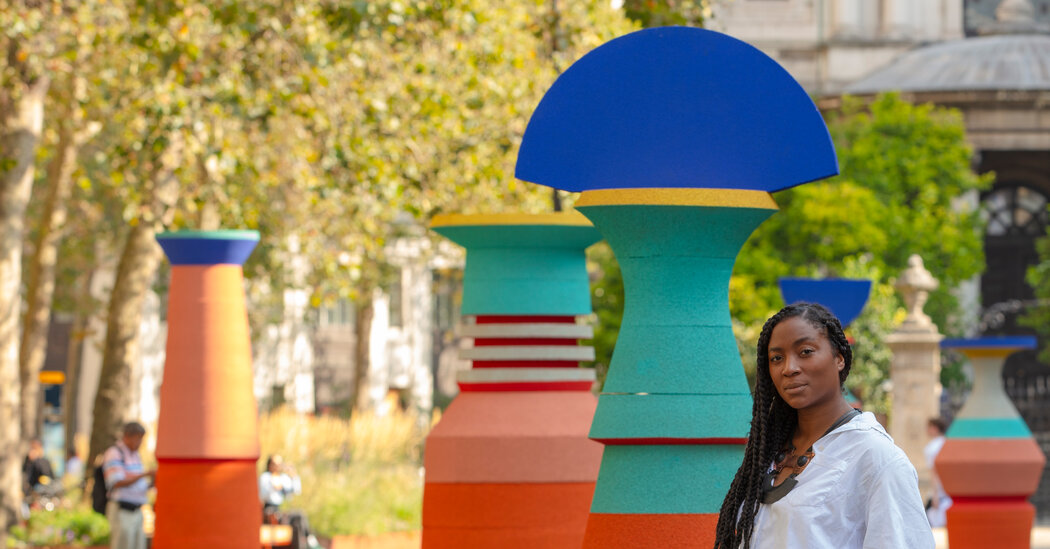
The multidisciplinary artist does everything from woodworking to painting.
As part of the preparations for her first solo exhibition, held this past summer at the NOW Gallery in South London, Simone Brewster designed “Crown,” a set of wooden combs inspired by traditional African hairstyles.
But since the multidisciplinary artist and designer already was creating jewelry and paintings for the selling show, designing its layout and furniture — not to mention caring for her son Omar, born in July 2022 — she decided in May to look for a manufacturer to produce her comb designs.
Six weeks later, unable to find anyone who could execute the small but complex designs, Ms. Brewster was about to give up. Then Max Lamb, a friend and fellow designer, offered his workshop, which had the band saw, pillar drills and sanding machines she needed to make them herself.
“It went from being this really stressful thing, because no one would make them for me, to something really fun,” said the designer, 40, who has picked up a variety of craft skills since she studied woodworking at school. “Once I know I’m going to make something, it’s not stressful for me because I know I can do it.”
The final pieces, in black palm and sapele wood, feature the same feminine curves and energy that characterize much of Ms. Brewster’s work. Her creations, sold mostly through her website, range in price from 300 pounds, or $365, for a pair of gold vermeil earrings to more than 15,000 pounds for furniture and precious jewelry. They include pieces in many sizes and materials, but all focus on how race, gender, and personal identity shape our understanding of design.
At the NOW Gallery show, for example, the combs were displayed alongside “Mammy,” a sculptural ebonized tulipwood table 20 inches wide, and “Negress,” a matching 4.2-foot-long chaise longue. Ms. Brewer shaped their supports to resemble a Black woman’s legs, breasts and head, reflecting on the history of Black women as possessions and plantation household items that depicted them, like a planter in the shape of a Black woman’s head. The Museum of London acquired “Mammy” in 2021.
Danielle Thom of the Design Museum in London, who arranged the purchase of “Mammy” while she was the Museum of London’s curator of making, wrote in an email that both “Mammy” and “Negress” “are incredibly powerful pieces, drawing on the visual languages of surrealism and Afrofuturism. They encompass a narrative at once personal and global, drawing on Simone’s own Afro-Caribbean heritage and the longer history of physical and spiritual oppression endured by women of color across centuries.”
One of Ms. Brewster’s first jewelry pieces, a bold necklace in ebony and silver, also was acquired earlier this year by the Victoria and Albert Museum.
“My work has a really strong narrative in it, like the ‘Negress’ and ‘Mammy,’” Ms. Brewster said, “or it’s about filling this gap that exists in the design world, where we don’t have design or objects that talk about histories and people who are like me, from the Caribbean or African diaspora, who actually like design, who are interested in art, who are interested in architecture.”
Color, in its myriad hues, is another constant component in Ms. Brewster’s work. At the NOW Gallery, which celebrates the work of emerging artists and makers, the exhibition space she designed included vibrant shades of pink, blue, yellow and green in the freewheeling curves of her paintings to the playfulness of her custom display cases, screens and a long table where visitors (even children) could use the simple stamps she created to try block printing for themselves. The exhibition was “designed in a way that makes you want to come in,” she said.
Jemima Burrill, the gallery’s curator, said Ms. Brewster’s exhibition attracted visitors who wouldn’t normally come into the gallery. “There’s a down to earth unpreciousness to her work that makes it so enticing,” she said.
Ms. Brewster used a similar color palette in her latest project, an installation called “Spirit of Place” that was displayed through Oct. 9 along the Strand, a pedestrian thoroughfare in Central London, as part of the London Design Festival. Invited by the festival organizers to partner with Amorim Cork, a Portuguese manufacturer, she created five cork sculptures as much as 8.3 feet tall.
For Kirsteen Martin, director of projects at London Design Festival, it was the perfect match. “Amorim is a family-run company committed to sustainable farming and Simone’s really connected to family and heritage, history and longevity. There’s a maternal energy to a lot of her work,” she said. “Like Simone, Amorim is run by a strong female character and to me, the sculptures represent female strength.”
The project was meant for the 2022 festival, but Amorim wanted her to visit its cork forest in central Portugal before starting work and her pregnancy delayed the trip. Eventually arriving in February with her husband and son in tow, she ended up redesigning the pieces once she had seen the company’s efforts to expand the forest, and had discovered the potential of cork as a natural, recyclable product.
Ms. Brewster’s work reflects her varied education in art and design. Growing up in North London, the daughter of a Jamaican mother and Trinidadian father, she excelled in mathematics and art and was encouraged to train as an architect. She was in her first year at the Bartlett School of Architecture at University College London when the woodworking skills she had picked up at school became useful. “It was a very new world and the only place I felt really comfortable in, and clearly excelled beyond everyone else, was when we had projects to make in the workshop,” she said.
Once she had completed the first part of her architecture degree, she decided to take a break — and won a place in the Royal College of Arts’ Design Products Master of Arts program, where, she said, she enjoyed exploring everything from metalworking to ceramics with tutors with a broad range of design philosophies like the designer Tom Dixon and Hannes Koch of the art collective Random International.
“In my first year,” she said, “I ended up doing eight projects instead of four, just so I could get as much information as I could.” (She never completed the architectural program.)
Ms. Brewster said becoming a teacher herself — with classes at the David Game College in London and the London College of Fashion’s Study Abroad program, among others — has had a profound effect on her own work, and helped to support it. “Learning how to teach is difficult, and to become a good teacher takes effort and consistent working to redevelop your way of seeing,” she said. “If you don’t see clearly you can’t really teach someone else.”
It was during the pandemic lockdown that she began working on her newest skill, painting. She and her then-boyfriend, now her husband, started painting as a kind of at-home date night activity.
She said it took time to find her style but she welcomed the freedom and immediacy of working in pastels, oils and watercolors, things that cutting and soldering metal for a necklace or turning wood to create a piece of furniture cannot provide.
The fluid paintings she created for her gallery exhibition, which were as much as 6 feet tall, returned to the themes in “Mammy,” depicting women as separate elements. “A woman is judged for being sexy or intelligent or for having a nice bum,” she said. “Why can’t she be all of these things at once?”
Since Ms. Brewster became a mother, she said she has often been asked how that has changed her approach to art. “When motherhood comes along, so many things change physically and emotionally,” she said. “The one thing that was there before that I still had access to was my own creativity.”
As for what medium she will work in next, she has no definite plan. “Working across different media is always an accident. It’s all about following curiosity with creativity,” she said.
But she is certain that she will continue to create with her own hands. “Making is the reason why I’m here,” she said.
This post was originally published on this site be sure to check out more of their content.







